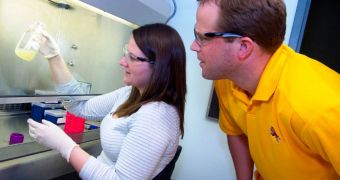A group of scientists at the Arizona State University (ASU) is currently investigating the possibility of using biomaterials as an alternative to petroleum, for the production of styrene. This is an absolutely critical chemical, used in a wide range of applications today.
Styrene is useful for creating tires, shows, a number of medical devices, insulating materials and many other things, but its main drawback is the fact that it uses petroleum to do so. That particular resource has been dwindling for decades, and will continue to decline until it's all gone.
Considering that the United States alone produces about 6 billion metric tons of styrene annually, changing the manufacturing process from using petroleum to using sustainable biomaterials would have numerous benefits.
It's also worthy to mention that about 3 metric tons of Steam are needed for each metric ton of styrene produced, which makes its manufacturing process one of the most resource-intensive ever. The result is the release of massive amounts of carbon dioxide in Earth's atmosphere.
The ASU team, which is led by experts David Nielsen and Rebekah McKenna, are hoping that their new efforts will lead to the development of a new, renewable materials-based styrene manufacturing process. If they succeed, the aforementioned negative environmental impacts would be eliminated.
One of the main directions of research is creating the chemical from genetically engineered bacteria. This can be done by manipulating certain pathways in the microorganisms so that they produce styrene as a byproduct.
“What we’ve done is create a new metabolic pathway. We’ve found the particular genes and enzymes required to achieve the necessary chemistry, and we have strung them together in a way that enables our engineered bacteria to function as a sort of biological catalyst,” Nielsen explains.
“In this way the cells can perform all of the biochemical reactions required to convert sugars like glucose into styrene,” says the expert, who is an assistant professor of chemical engineering in the ASU School for Engineering of Matter, Transportation and Energy.
What this implies is that their work is centered around constructing microscopic microbial chemical factories, capable of being organized in cultures, and producing the required chemical around the clock.
Admittedly, it would take some time until production from such sources would rival that of conventional ones, but the team believes that this can be achieved sooner rather than later. Furthermore, the existing infrastructure will need no modifications to accommodate the new technology.
“We hope to be able to develop viable renewable alternatives for the bio-plastics industry. From there, we might be able to begin making all sorts of new products from renewable, biological materials,” Nielsen concludes.

 14 DAY TRIAL //
14 DAY TRIAL //